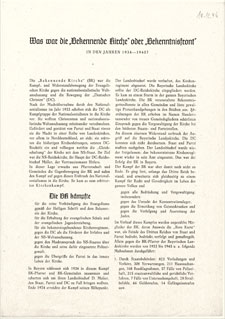Self-Portrayal as a Resistance Organization
A conception of history, in which the Evangelical Lutheran Church in Bavaria portrayed itself as an organization that had resisted National Socialism, developed quickly in the immediate postwar period. Its own entanglement in National Socialism was largely left out of the account, although critical opinions also drew attention to the church’s failure. This conception of history of the church as a resistance organization governed the church’s self-perception well into the 1960s.
Several factors played a role in the development of this conception of history. Altogether, the regional church’s confrontation of its past under the Nazi regime was given little attention in the situation in devastated postwar Germany, which was governed by existential needs. Like German Protestants elsewhere, the church focused on material reconstruction and care for refugees and displaced person, who arrived in Bavaria in large numbers especially.
The development of this conception of history was furthered by the occupying powers, which viewed the churches as the sole major social organizations that had not been corrupted by National Socialism. The military governments drew on church officials as advisors and negotiating partners. This was the case with Regional Bishop Hans Meiser (1881-1956), too, whom the American army immediately brought back from his provisional quarters in Ansbach to Munich at the end of the war.
The identification of the church as a resistance organization took on great significance, especially in conjunction with denazification. In order to be able to protect its pastors, the church government began collecting evidence of the church’s resistance against the Nazi regime. To this end, it began a taking a survey at the end of 1945 of the state and party’s persecutory measures against pastors. A ruling by the court of appeals in the Bavarian special ministry in October of 1946 officially recognized the Confessing Church as a resistance movement.
Shortly after this ruling, the regional consistory circulated large numbers of the pamphlet Was war die “Bekennende Kirche” oder “Bekenntnisfront” in den Jahren 1934–1945? (What was the “Confessing Church” or “Confessional Front” in the Years 1934–1945?), which furnished pastors and parishioners arguments to prove the church’s resistance. The conclusion of the pamphlet read:
Thus, whoever was a member of the Confessing Church and actively supported its cause was active in a fighting and resistance organization, opposed National Socialism and its weltanschauung and had to expect to suffer sanctions as a result. When party members joined the Confessing Church, they thus gave proof that they were inwardly distanced from the Nazi weltanschauung and German Christian spirit and that they placed faithfulness to their church, love for their nation and obedience to divine commandments of righteousness and truth higher than party membership.
The “collective experience of resistance” of October of 1934, when entire segments of the Protestant populace had opposed the removal of Regional Bishop Meiser, played a central role in general, not only for the pamphlet but also for the development of the conception of history of the church as a resistance organization. This experience had become deeply ingrained in collective memory throughout all strata of the regional church and was interpreted as resistance against the Nazi regime as such in the church’s self-perception.
Source / title
- © Landeskirchliches Archiv Nürnberg, LKR 180


